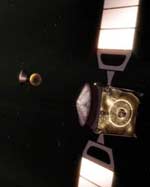
Image credit: ESA
Mars Express has got just one chance to get this right. In two days the Beagle 2 lander will separate from the spacecraft; next stop, Mars. Beagle 2 has to be traveling at exactly the right trajectory so that it hits the Martian atmosphere at the right angle so that it doesn’t burn up or skip off into deep space. This trajectory would crash Mars Express into the Red Planet, so after it lets go of Beagle 2, it has to change its own trajectory to go into a safe orbit.
Any football or rugby fan knows that when a player kicks the ball, there is no longer anything they can do to influence its path. The player must trust to their own skill for the ball to reach its intended destination.
What has all this to do with Mars Express? Three days from now, on 19 December 2003, Mars Express must, like an expert rugby player, ?pass? Beagle 2 on to the next player, Mars. The problem is that Beagle 2 has no thrusters on board, so cannot influence its own trajectory.
Right place at the right time
To equip the lander with rockets would have made it far too heavy to transport on Mars Express. Instead, engineers at the European Space Operations Centre (ESOC) in Darmstadt, Germany, will precisely orientate the Mars Express spacecraft to point Beagle 2 at Mars. Everything relies on dropping Beagle 2 in the right place at the right time.
Collision course…
In order to do this, Mars Express has been following a trajectory that will lead to Beagle 2?s touchdown point. That puts the whole mission in danger, because it means that Mars Express is effectively on a collision course with the planet.
If nothing is done to alter its trajectory, instead of falling into orbit, Mars Express will slam into Mars on 25 December. Yet nothing can be done to avert this impending catastrophe until Beagle 2 has been released, since to move the spacecraft beforehand would ruin the landing.
At ejection, the spacecraft simply lets go of the lander. Beagle 2 will be spun to keep it stable and pushed away with the gentlest of forces; nothing dramatic like a ‘blast off’ at launch. Then, and only then, can engineers send the necessary commands for Mars Express to fire its engine and alter its course to avoid destruction on the surface of Mars.
Original Source: ESA News Release
